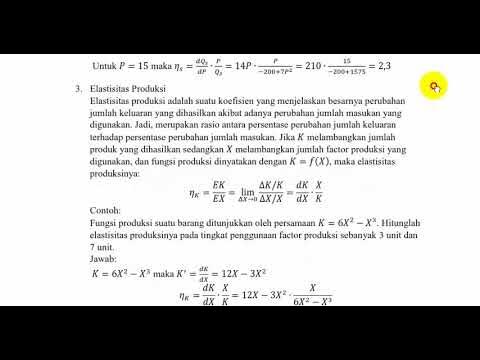Elastisitas Permintaan dan Penawaran
Summary
TLDRThis educational video explores the concept of elasticity in economics, focusing on demand and supply. It begins with a definition of elasticity and its significance in understanding market behavior. The video outlines different types of elasticity, including perfectly inelastic, inelastic, unit elastic, elastic, and perfectly elastic, accompanied by relevant examples. It also provides formulas for calculating elasticity coefficients and discusses factors that influence elasticity. Engaging with practical problems, the lesson reinforces concepts and prepares students for real-world applications in economic analysis.
Takeaways
- 😀 Elasticity of demand measures how responsive the quantity demanded is to changes in price.
- 📉 The law of demand states that as price increases, the quantity demanded decreases, and vice versa.
- 🔍 The coefficient of elasticity is calculated by dividing the percentage change in quantity demanded by the percentage change in price.
- ⚖️ There are five types of elasticity: perfectly inelastic, inelastic, unit elastic, elastic, and perfectly elastic.
- 🛑 Perfectly inelastic demand means quantity demanded remains constant regardless of price changes (coefficient = 0).
- 🔄 Inelastic demand indicates that quantity demanded changes less than proportionately to price changes (coefficient < 1).
- 💡 Unit elastic demand occurs when the quantity demanded changes exactly proportionately to price changes (coefficient = 1).
- 🌱 Elastic demand suggests that quantity demanded changes more than proportionately to price changes (coefficient > 1).
- 🛢️ Perfectly elastic demand means that any price change results in an infinite change in quantity demanded (coefficient is infinite).
- 📊 Factors influencing demand elasticity include availability of substitutes, proportion of income spent, necessity vs. luxury goods, and diversity of use.
Q & A
What is the main focus of the lesson discussed in the transcript?
-The main focus of the lesson is the elasticity of demand and supply, specifically understanding price elasticity in economics.
How is price elasticity of demand defined in the transcript?
-Price elasticity of demand is defined as a measure of how much the quantity demanded of a good responds to changes in its price.
What is the formula for calculating the coefficient of price elasticity of demand?
-The coefficient of price elasticity of demand can be calculated using the formula: % change in quantity demanded / % change in price.
What are the different types of price elasticity of demand mentioned?
-The different types include perfectly inelastic, inelastic, unitary elastic, elastic, and perfectly elastic demand.
What is an example of perfectly inelastic demand given in the transcript?
-An example of perfectly inelastic demand is medicine, where demand remains unchanged regardless of price changes.
How does the transcript describe the relationship between price changes and quantity demanded in elastic demand?
-In elastic demand, a small change in price leads to a more significant change in quantity demanded; specifically, if price changes by 1%, quantity demanded changes by more than 1%.
What factors influence the elasticity of demand according to the transcript?
-Factors influencing the elasticity of demand include the availability of substitute goods, the proportion of income spent on the good, whether the good is a necessity or luxury, and the variety of uses for the good.
What are the main factors affecting supply elasticity mentioned in the transcript?
-The main factors affecting supply elasticity include production time, the durability of goods, the mobility of production factors, and the ease with which new producers can enter the market.
What type of elasticity is indicated if the coefficient of elasticity is equal to 1?
-If the coefficient of elasticity is equal to 1, it indicates unitary elasticity, where the percentage change in quantity demanded is equal to the percentage change in price.
How is the calculation of the elasticity coefficient demonstrated in the transcript?
-The calculation is demonstrated through an example involving the price and quantity of beef, where the coefficient is calculated based on initial and new prices and quantities to determine the type of elasticity.
Outlines

Cette section est réservée aux utilisateurs payants. Améliorez votre compte pour accéder à cette section.
Améliorer maintenantMindmap

Cette section est réservée aux utilisateurs payants. Améliorez votre compte pour accéder à cette section.
Améliorer maintenantKeywords

Cette section est réservée aux utilisateurs payants. Améliorez votre compte pour accéder à cette section.
Améliorer maintenantHighlights

Cette section est réservée aux utilisateurs payants. Améliorez votre compte pour accéder à cette section.
Améliorer maintenantTranscripts

Cette section est réservée aux utilisateurs payants. Améliorez votre compte pour accéder à cette section.
Améliorer maintenantVoir Plus de Vidéos Connexes

The 4 Types of Elasticity Explained | Economic Homework | Think Econ

Elasticity Overview and Tips- Micro Topics 2.3, 2.4, and 2.5

ELASTISITAS PERMINTAAN, PENAWARAN DAN PRODUKSI

Chapter 5. Exercises 1-7. Elasticity and its application.

Quipper Video - Ekonomi - Elastisitas - Kelas 10

ELASTISITAS PERMINTAAN DAN PENAWARAN
5.0 / 5 (0 votes)
